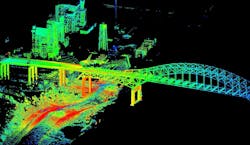DARPA asks industry for multi-wavelength lasers for next-generation optical computing, sensors, and LiDAR
ARLINGTON, Va. – U.S. military researchers are surveying industry to determine the feasibility of multi-wavelength lasers for integrated silicon photonics in military applications like optical communications, optical signal processing, and light-field displays for augmented and virtual reality.
Officials of the U.S. Defense Advanced Research Projects Agency (DARPA) in Arlington, Va., issued a small-business opportunity solicitation (HR001121S0007-07) last week for the Multi-Wavelength Laser Sources project.
The goal is to develop efficient, compact, manufacturable multi-wavelength laser sources that are critical for co-packaged optical interconnects, advanced data processing, sensors, and other emerging silicon photonics applications.
These kinds of electro-optical enabling technologies also will support the DARPA Package for Extreme Scalability (PIPES) program, which seeks to enable next-generation microelectronics with co-packaged optical I/O for future high-performance military and commercial systems such as optical computing.
Related: The new horizon of optical computing
In the military, multi-wavelength lasers are expected to be important building blocks for high-throughput interconnects in high-performance computing; edge processing; emerging artificial intelligence (AI) and machine learning systems; sensors; high-bandwidth microwave photonic systems; and coherent light direction and ranging (LiDAR).
Short-reach optical interconnects historically have used a small portion of the optical spectrum, with current architectures using only one to a few wavelengths per fiber, DARPA researchers explain. However, as the demands on bandwidth and efficiency increase, advances in compact multi-wavelength laser sources are required to enable next-generation co-packaged photonic I/O.
DARPA researchers are looking for technical approaches to multi-wavelength laser sources that are compatible with chip-scale fabrication and integration methods.
They want solutions that deliver at least 16 laser channels on a regular frequency grid, with about 100 to 800 GHz spacing, in the O-band and C-band of the spectrum to provide milliwatt power levels per channel.
Companies interested must show a feasible path for a multi-wavelength laser, and describe potential commercial applications. DARPA wants to find a domestic commercial source for multi-wavelength laser sources specifically targeting optical interconnects and computing.
Proposers must outline a clear path to deliver hardware prototypes within two years, and deliver 10 multi-wavelength laser prototypes by program's end with electronic control and optical fiber outputs.
Companies interested should upload proposals no later than 25 May 2021 to the Defense SBIR/STTR Innovation Portal at www.dodsbirsttr.mil.
Email questions or concerns to DARPA at [email protected]. More information is online at https://beta.sam.gov/opp/2e23f6a5e3104da6bf819d31822edb95/view.
